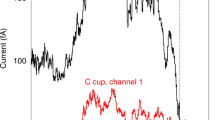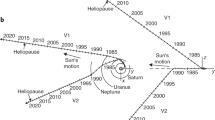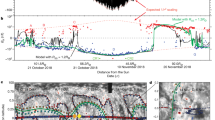Abstract
Voyager 1 has been in the reservoir of energetic ions and electrons that constitutes the heliosheath since it crossed the solar wind termination shock1,2,3 on 16 December 2004 at a distance from the Sun of 94 astronomical units (1 au = 1.5 × 108 km). It is now ∼22 au past the termination shock crossing4. The bulk velocity of the plasma in the radial–transverse plane has been determined5 using measurements of the anisotropy of the convected energetic ion distribution6. Here we report that the radial component of the velocity has been decreasing almost linearly over the past three years, from ∼70 km s−1 to ∼0 km s−1, where it has remained for the past eight months. It now seems that Voyager 1 has entered a finite transition layer of zero-radial-velocity plasma flow, indicating that the spacecraft may be close to the heliopause, the border between the heliosheath and the interstellar plasma. The existence of a flow transition layer in the heliosheath contradicts current predictions7—generally assumed by conceptual models—of a sharp discontinuity at the heliopause.
This is a preview of subscription content, access via your institution
Access options
Subscribe to this journal
Receive 51 print issues and online access
$199.00 per year
only $3.90 per issue
Buy this article
- Purchase on Springer Link
- Instant access to full article PDF
Prices may be subject to local taxes which are calculated during checkout


Similar content being viewed by others
References
Decker, R. B. et al. Voyager 1 in the foreshock, termination shock, and heliosheath. Science 309, 2020–2024 (2005)
Burlaga, L. F. et al. Crossing the termination shock into the heliosheath: magnetic fields. Science 309, 2027–2029 (2005)
Stone, E. C. et al. Voyager 1 explores the termination shock region and the heliosheath beyond. Science 309, 2012–2020 (2005)
Decker, R. B., Krimigis, S. M., Roelof, E. C. & Hill, M. E. Variations of low-energy ion distributions measured in the heliosheath. AIP Conf. Proc. 1302, 51–57 (2010)
Krimigis, S. M. et al. The Low Energy Charged Particle (LECP) experiment on the Voyager spacecraft. Space Sci. Rev. 21, 329–354 (1977)
Krimigis, S. M. et al. Voyager 1 exited the solar wind at a distance of 85 au from the Sun. Nature 426, 45–48 (2003)
Florinski, V. et al. The dynamic heliosphere: outstanding issues. Space Sci. Rev. 143, 57–83 (2009)
Scientific exploration: What a long, strange trip it’s been. Nature 454, 24–25 (2008)
Suess, S. T. The heliopause. Rev. Geophys. 28, 97–115 (1990)
Krimigis, S. M., Mitchell, D. G., Roelof, E. C., Hsieh, K. C. & McComas, D. J. Imaging the interaction of the heliosphere with the interstellar medium from Saturn with Cassini. Science 326, 971–973 (2009)
Krimigis, S. M., Mitchell, D. G., Roelof, E. C. & Decker, R. B. ENA (E > 5 keV) images from Cassini and Voyager “ground truth”: suprathermal particle pressure in the heliosheath. AIP Conf. Proc. 1302, 79–85 (2010)
Decker, R. B., Roelof, E. C., Krimigis, S. M. & Hill, M. E. in Physics of the Heliosphere: A 10-Year Retrospective (eds Heerikhuisen, J., Li, G. & Zank, G. ) (10th Annu. Internat. Astrophys. Conf., American Institute of Physics, 2011)
Roelof, E. C. et al. Implications of generalized Rankine-Hugoniot conditions for the PUI population at the Voyager 2 termination shock. AIP Conf. Proc. 1302, 133–141 (2010)
Izmodenov, V. V. et al. Kinetic-gasdynamic modeling of the heliospheric interface. Space Sci. Rev. 146, 329–351 (2009)
Zank, G. P. Physics of the solar wind-local interstellar medium interaction: role of magnetic fields. Space Sci. Rev. 146, 295–327 (2009)
Acknowledgements
This work was supported at The Johns Hopkins University Applied Physics Laboratory by NASA. We are grateful to J. Aiello (for assistance with our graphical presentation) and R. McNutt (for a historical summary of heliosheath terminology).
Author information
Authors and Affiliations
Contributions
S.M.K. contributed most of the text; E.C.R. contributed to the text and provided theory interpretation; and R.B.D. performed the data analysis with the assistance of M.E.H.
Corresponding author
Ethics declarations
Competing interests
The authors declare no competing financial interests.
PowerPoint slides
Rights and permissions
About this article
Cite this article
Krimigis, S., Roelof, E., Decker, R. et al. Zero outward flow velocity for plasma in a heliosheath transition layer. Nature 474, 359–361 (2011). https://doi.org/10.1038/nature10115
Received:
Accepted:
Published:
Issue Date:
DOI: https://doi.org/10.1038/nature10115
This article is cited by
-
Future Exploration of the Outer Heliosphere and Very Local Interstellar Medium by Interstellar Probe
Space Science Reviews (2023)
-
Oblique and rippled heliosphere structures from the Interstellar Boundary Explorer
Nature Astronomy (2022)
-
The Early History of Heliospheric Science and the Spacecraft That Made It Possible
Space Science Reviews (2022)
-
Observations of the Outer Heliosphere, Heliosheath, and Interstellar Medium
Space Science Reviews (2022)
-
The Structure of the Large-Scale Heliosphere as Seen by Current Models
Space Science Reviews (2022)
Comments
By submitting a comment you agree to abide by our Terms and Community Guidelines. If you find something abusive or that does not comply with our terms or guidelines please flag it as inappropriate.



